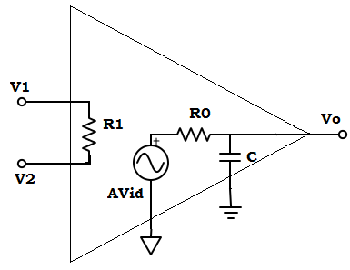This set of Linear Integrated Circuit Multiple Choice Questions & Answers (MCQs) focuses on “Open-Loop Voltage Gain as a Function of Frequency – 1”.
1. Determine the output voltage for an op-amp with single break frequency.

a) VO ={ jXC /[Ro+(iXC)]} × AVid
b) VO = = AVid / [1+ j2πfRoC].
c) VO = AVid /(Ro+j2πfC)
d) VO = Vid / [Ro-(j2πfRoC)].
View Answer
Explanation: The output voltage for an op-amp with single break frequency,
VO = {(-jXC) / [(Ro)-(jXC)} ×AVid
∵ -j=1/j & XC =1/2πfC
=> VO = {(1/j2ΠfC)/[Ro + (1/ j2πfC)] } × AVid = AVid / [1+ j2πfRoC].
2. Compute the break frequency of an op-amp, if the output resistance=10kΩ and capacitor connected to the output =0.1µF.
a) 159.2Hz
b) 6.28Hz
c) 318.4Hz
d) 1000Hz
View Answer
Explanation: Break frequency of the op-amp is given as fo = 1/(2πRoC)= 1/ (2π×10kΩ×0.1µF) = 1/ (6.28×10-3) = 159.2Hz.
3. The open loop voltage gain as a function of frequency is defined as
a) AOL(f) = VO/Vin
b) AOL(f) = VO/Vid
c) AOL(f) = VO/Vf
d) All of the mentioned
View Answer
Explanation: The open loop voltage gain as a function of frequency is defined as ratio of output voltage to the difference of input voltages.
4. Which among the following factor remain fixed for an op-amp?
a) Open loop voltage gain
b) Gain of the op-amp
c) Operating frequency
d) Break frequency of the op-amp
View Answer
Explanation: Break frequency fo depends on the value of capacitors and on output resistance. Therefore, fo is fixed for any op-amp.
5. Find the gain magnitude and phase angle of the op-amp using the specifications:
f= 50Hz; fo=5Hz ; A=140000.
a) AOL(f)= 22.92dB , Φ(f) = – 89.99o
b) AOL(f)= 66dB , Φ(f) = – 90o
c) AOL(f)= 26dB, Φ(f) = – 89.99o
d) AOL(f)= 20dB , Φ(f) = – 84.29o
View Answer
Explanation: The open loop gain magnitude |AOL(f)|= 20log[A/√[1+ f/fo)2] = 20logA-20 log[A/√ [1+(f/fo)2] = 20log(140000)- 20log[√(1+(50,000/5)2)] AOL(f) dB= 102.922-80 = 22.92dB.
Phase angle, φ(f) = -tan-1(f/fo) = -tan-1(50000/5) = -89.99o.
6. Consider an op-amp where the inverting input voltage =3.7mv, non-inverting input voltage=6.25mv and open loop voltage gain =142dB. Find the output voltage.
a) 0.21v
b) 0.45v
c) 0.78v
d) 0.36v
View Answer
Explanation: Open loop voltage gain, AoL(f) = Vo/Vid
VO = AOL(f) × (Vin1-Vin2) = 142 dB×(6.25-3.7) = 142×2.55 = 0.36v.
7. Express the open loop gain of the op-amp in complex form?
a) A/√ [1+(f/fo)2
b) 20log{A/√[1+(f/fo)2}
c) A/[1+j(f/fo)].
d) None of the mentioned
View Answer
Explanation: The open loop gain of the op-amp AOL(f) is a complex quantity and is expressed as AOL(f) = A/[1+ j(f/fo)] . The remaining equations are expressed in polar form.
8. Determine the difference between two AOL(f) at 50Hz and 500Hz frequency? (Consider the op-amp to be 741c)
a) 40dB
b) 30dB
c) 20dB
d) 10dB
View Answer
Explanation: AOL(f) dB= 20log[√ [1+ (f/fo)2] At f= 50 Hz,
AOL(f) dB = 20log(200000)- 20log(√(1+(50/5)2) = 106.02-20.04 ≅ 86dB
At f= 500Hz
AOL(f) dB =20log(200000)-20log(√(1+(500/5)2) = 106.02-40 ≅ 66dB
Therefore, the difference between AOL(f)dB = 86-66 = 20dB.
9. At what frequency, the phase shift between input &output voltage will be zero?
a) -40Hz
b) 0Hz
c) -22Hz
d) 20Hz
View Answer
Explanation: At 0Hz the phase shift between input and output voltage is zero.
At f=0Hz, φ(f) = – tan-1 (f/fo) = -tan-1(0/5) = 0o
10. At what frequency AOL(f)=A?
a) 50Hz
b) 10Hz
c) 5Hz
d) 0Hz
View Answer
Explanation: For any frequency less than break frequency (fo =5Hz) the gain is approximately constant and is equal to A. For example, fo =0Hz,
Then AOL(f) dB= 20log(200000-20log[√1+(0/5)2)] = 106dB. Where A =20,000 ≅ 106dB.
11. What happen when the frequency increases?
a) AOL(f) continues to drop
b) A increases
c) fo –> 0Hz
d) None of the mentioned
View Answer
Explanation: The open loop voltage gain as a function of frequency is given as AOL(f) = A/ [√ 1+ (f/fo)] at frequency above fo, the denominator value increases, causing the gain, AOL(f) to decrease. Thus, as frequency increases, the gain AOL(f) continuous to drop.
12. What will be the absolute value of phase shift, if the frequency keeps increasing?
a) Increase towards 45o
b) Decrease towards 45o
c) Increase towards 90o
d) Decrease towards 90o
View Answer
Explanation: For any frequency above break frequency, the absolute value of phase shift increases towards 90o with increase in frequency.
Sanfoundry Global Education & Learning Series – Linear Integrated Circuits.
To practice all areas of Linear Integrated Circuits, here is complete set of 1000+ Multiple Choice Questions and Answers.
If you find a mistake in question / option / answer, kindly take a screenshot and email to [email protected]
- Check Linear Integrated Circuits Books
- Practice Electrical Engineering MCQs
- Practice Electronics & Communication Engineering MCQs
- Check Electrical Engineering Books
- Apply for Electrical Engineering Internship
